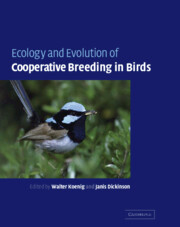Book contents
- Frontmatter
- Contents
- List of contributors
- Introduction
- 1 Evolutionary origins
- 2 Delayed dispersal
- 3 Fitness consequences of helping
- 4 Parental care, load-lightening, and costs
- 5 Mating systems and sexual conflict
- 6 Sex-ratio manipulation
- 7 Physiological ecology
- 8 Endocrinology
- 9 Incest and incest avoidance
- 10 Reproductive skew
- 11 Joint laying systems
- 12 Conservation biology
- 13 Mammals: comparisons and contrasts
- 14 Summary
- Names of bird and mammal species mentioned in the text
- References
- Taxonomic index
- Subject index
3 - Fitness consequences of helping
Published online by Cambridge University Press: 02 December 2009
- Frontmatter
- Contents
- List of contributors
- Introduction
- 1 Evolutionary origins
- 2 Delayed dispersal
- 3 Fitness consequences of helping
- 4 Parental care, load-lightening, and costs
- 5 Mating systems and sexual conflict
- 6 Sex-ratio manipulation
- 7 Physiological ecology
- 8 Endocrinology
- 9 Incest and incest avoidance
- 10 Reproductive skew
- 11 Joint laying systems
- 12 Conservation biology
- 13 Mammals: comparisons and contrasts
- 14 Summary
- Names of bird and mammal species mentioned in the text
- References
- Taxonomic index
- Subject index
Summary
Cooperatively or communally breeding birds are species in which individuals live in groups of three or more breeding-aged adults, all of which care for young at a single nest (Brown 1987; Stacey and Koenig 1990a). Most cooperative breeders retain young that delay breeding and help their parents raise siblings. Additional forms of cooperative breeding include polygamous groups with multiple cobreeders of one or both sexes and, more rarely, groups with unrelated helpers. Cooperative breeding is rare, occurring in only about 3% of avian species worldwide, and is particularly common in Australian birds (Brown 1987; Russell 1989; Arnold and Owens 1998). Its prevalence in Australasia can be accounted for phylogenetically due to a particularly high frequency in the Corvida (23%) (Russell 1989; Edwards and Naeem 1993; Clarke 1995).
Theoretical and comparative treatments of avian cooperative breeding have usually dealt with the full range of avian social systems (Brown 1987; Koenig et al. 1992; Hartley and Davies 1994; Arnold and Owens 1998). This practice has demonstrated that cooperative breeders share many important characteristics, such as year-round residency, high survivorship, small clutch sizes, and, in many cases, constraints on independent breeding (Brown 1987; Stacey and Koenig 1990a; Arnold and Owens 1998, 1999). Specific limitations on independent breeding vary from one species to the next, and involve a variety of resources, including food, territories, suitable nest or roosting sites, and a lack of skill or mates (Smith 1990).
The primary focus of this chapter is helping at the nest by retained offspring.
- Type
- Chapter
- Information
- Ecology and Evolution of Cooperative Breeding in Birds , pp. 48 - 66Publisher: Cambridge University PressPrint publication year: 2004
- 130
- Cited by

